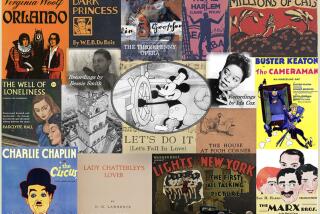Software Helps Tame the Copyright Jungle
- Share via
Executives at the nonprofit National Geographic Society see gold in the videos they’ve amassed of exotic locales and roving wildlife.
But each of the hundreds of thousands of clips in the society’s vault comes with a tangle of strings attached, thick as a jungle.
A producer may hold distribution rights outside the United States. A song in the soundtrack may be cleared to play in Asia but not in Africa. And a billboard in the background may show the logo for a brand-name sneaker, requiring the shoe’s manufacturer to weigh in.
All that can be intimidating to filmmakers, ad agencies and others that might want to use the footage. So the society is trying to make its collection more accessible, with a Web site where customers can review its vast trove and apply for myriad licenses.
The site is powered by software developed by RightsLine Inc. of Beverly Hills, which sees a gold mine of its own in helping companies sort through the maze of overlapping copyrights affecting their video, music, images and trademarks.
RightsLine was founded in 1999 by three former executives at database powerhouse Oracle Corp.
Russell P. Reeder, RightsLine’s chief executive, said the major bottleneck for media companies has been understanding what they own -- what footage, images and other items they have the right to distribute, and where those rights apply.
The Internet has opened the door to a slew of new opportunities for offering content, but copyright law still can get in the way. Each segment of a video may be covered by different restrictions on where it can be shown, what it can be used for and when it can be sold.
RightsLine’s software is designed to track those restrictions down to a single frame of film. It also helps companies discover the rights they have yet to exploit. For example, a Hollywood studio may have licensed the rights to sell the Spanish-language DVD of a film in South America, but not the Portuguese version.
“Once you understand what you own, then you can create these new business models,” Reeder said.
The Internet-based approach doesn’t eliminate the need to have people physically review license applications to make sure footage or images won’t be used inappropriately or fuel copyright violations, a prime concern in an era of widespread Internet piracy.
Still, Vivendi Universal’s Universal Studios, which started using RightsLine’s software in 2001, has cut the approval time for the average deal from 10 days to two -- with some deals taking as little as 15 minutes, said Jeremy Laws, Universal Studios’ vice president of media licensing.
Universal also has seen revenue from its film clips and photographs go up 50% over the last two years, “and the rate of revenue growth continues to accelerate,” analysts Gale Daikoku and Van Baker of GartnerG2 reported in June.
What’s more, by making it easier for companies to obtain footage legally, Universal reduced the amount of unauthorized uses, said Robert Gleiberman, RightsLine’s chief operating officer.
Matthew White, vice president of the film library at National Geographic Television & Film, sees another potential benefit to his organization’s new Web site, which it plans to unveil this month. By eliminating much of the pain from licensing, the library hopes not only to spur more creative uses of its footage, but also to prompt other libraries to follow suit.
“We’re expecting others to come with us as well,” White said. “If we provide those kinds of tools to producers, all of these archives around the world open up.”
RightsLine is trying to attract more than just video companies.
Its customers also include telecommunications company Sprint Corp. and image clearinghouse Corbis Corp. Although the market for video “stock footage” is about $300 million worldwide, White said, the Licensing Industry Merchandisers Assn. estimates that the market for all copyrighted or trademarked images -- think Laker jerseys and Mickey Mouse watches -- is $105 billion in the U.S. alone.
As a result, the potential for firms that manage copyrights is huge.
NextQuarter, a corporate research firm in Rye, N.H., estimated that the market for rights-management software would rise from $3.1 billion in the U.S. this year to $5.5 billion over the next three years, and from $9 billion worldwide to $16.2 billion.
RightsLine steps in after a firm has done the painstaking work of combing through its contracts and cataloging all the restrictions on its assets. It lets its customers hide that complexity from potential licensees, while also keeping track of any new restrictions imposed by exclusive deals for footage or images.
White said that National Geographic Film & Television used to require customers to describe the footage they were looking for, then wait for the library’s researchers to send them segments on videotape that might fit their needs. If clients saw something they liked, they would have to come back to the library for a license and a copy suitable for broadcasting.
With the Web site, customers will be able to search through a digitized collection of about 100,000 videos, view and select the footage that suits their needs, and fill out a license application online. RightsLine’s software is designed to show only those clips that would be eligible for licensing.
The process still has some major flaws, White said, noting that the library can’t deliver master versions of the clips to most customers because of the lack of a standard format. But a group of stock-footage companies hopes to address those shortcomings through a trade association formed this year.
More to Read
The biggest entertainment stories
Get our big stories about Hollywood, film, television, music, arts, culture and more right in your inbox as soon as they publish.
You may occasionally receive promotional content from the Los Angeles Times.










